This is Part II of my two-part series on a trip to the Amalfi Coast in Italy with my family and Victor in June 2022. Make sure you read Part I first!
As I mentioned in my last post, the town of Amalfi is an amazing base for exploring the Amalfi Coast further. It has the most amount of ferries available, and the most restaurants and cafes to equip you for breakfast before setting off, as well as dinner when you’re back from an excellent day trip. We stayed in Amalfi for Days 1 and 2, but on Day 3 we went on our first day trip.

Ravello
We started with Ravello, a tiny, hidden yet grandiose place. It’s one of the quietest spots along the coast, hidden up in the mountains and away from the beach level. While this means there’s no beach access, it instead guarantees the best coastline view.
 The town has served historically as a destination for artists, musicians, and writers including the 14th-century Italian writer and poet Giovanni Boccaccio, composers Richard Wagner, Edvard Grieg and Leonard Bernstein (West Side Story), the Dutch graphic artist M. C. Escher, English writers Virginia Woolf and Graham Greene, the Spanish painter Joan Miró, the American playwright Tennessee Williams (A Street Car Named Desire), and Jacqueline Kennedy (Former First Lady of the U.S.).
The town has served historically as a destination for artists, musicians, and writers including the 14th-century Italian writer and poet Giovanni Boccaccio, composers Richard Wagner, Edvard Grieg and Leonard Bernstein (West Side Story), the Dutch graphic artist M. C. Escher, English writers Virginia Woolf and Graham Greene, the Spanish painter Joan Miró, the American playwright Tennessee Williams (A Street Car Named Desire), and Jacqueline Kennedy (Former First Lady of the U.S.).
We arrived at Ravello via bus and once we were walking we first came across the main square, overlooked by the Duomo di Ravello. Built in the 11th century with support from the Rufolo family, the Duomo’s architecture combines Baroque and Romanesque styles.



It’s no wonder Ravello attracted so many artists because the setting is so incredibly romantic and inspiring. The town is characterised by its grand and romantic villas. We visited the most famous of all, Villa Cimbrone.
Perched on the cliffs and overlooking the sea, Villa Cimbrone’s origins go back to the 11th century. Our earliest reference indicates that the villa belonged to the Accongiogioco, a noble family. It later passed to the ownership of a wealthy and influential family, the Fusco. It then became part of the nearby monastery of Santa Chiara. From the 17th century, the villa’s history is vague, but by the latter half of the 19th century, it had passed to the Amici family of Atrani. The various change of hands is reflected in the villa’s conglomerate of styles and buildings.


The villa was visited by the historian Ferdinand Gregorovius, who described it in his Siciliana: Wanderings in Naples and Sicily (1861). He mentioned the famous scenic belvedere, the Terrazza dell’Infinito (Terrace of Infinity). Adorned by classical marble busts perched on the railing, the Infinity Terrace is 300 meters (984ft) above sea level. It’s one of the most beautiful spots in the villa.

 Ernest Beckett had visited the villa during his travels in Italy and had fallen in love with it, even though the property had been largely neglected for some time. He bought it from the Amici family in 1904 and restored and expanded the villa and gardens. This resulted in many changes to the villa, or rather perhaps additions, of Gothic, Moorish, and Venetian architectural styles.
Ernest Beckett had visited the villa during his travels in Italy and had fallen in love with it, even though the property had been largely neglected for some time. He bought it from the Amici family in 1904 and restored and expanded the villa and gardens. This resulted in many changes to the villa, or rather perhaps additions, of Gothic, Moorish, and Venetian architectural styles.



Many famous visitors came to the villa during the Beckett family’s ownership. It was a favourite haunt of the Bloomsbury Group, including Virginia Woolf, Leonard Woolf, E. M. Forster, John Maynard Keynes, and Lytton Strachey. The villa is quite remarkable, with lovely gardens and spectacular views.
The other villa we visited in Ravello was Villa Rufolo. Together with Villa Cimbrone, it is one of the most beautiful villas to visit in Ravello (and anywhere along the Amalfi Coast). The villa was built by the Rufolo family around the 13th century. It too has lush gardens and various architectural structures from different periods. One of the highlights of the villa is its terraced garden which slopes down towards the sea and is adorned with colourful flowers, trees and fountains. We weren’t able to go directly onto the terrace because they were preparing for the Ravello Festival, an annual classical and Jazz music festival that takes place in Ravello in summer.
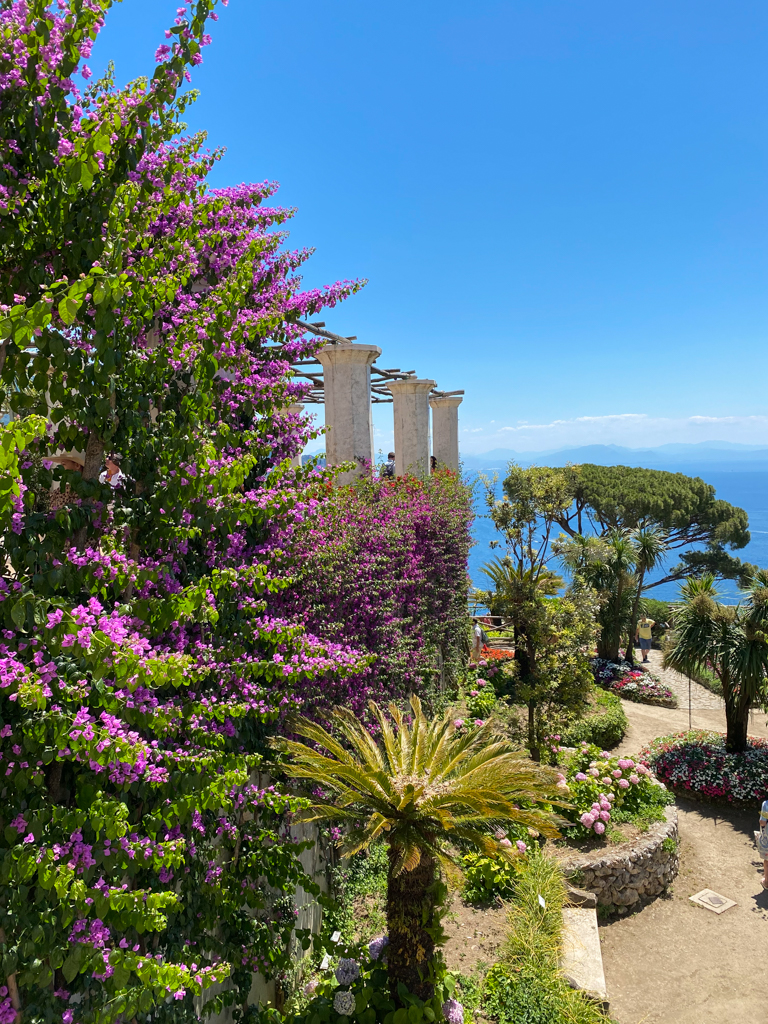

We ended our day trip with a spectacular lunch at Ristorante Bella Vista sul mare. There are quite a few restaurants with spectacular views here, but we went for this one as the prices were reasonable and the outdoor area was a bit smaller and more private than some of the other terraced restaurants. It was a beautiful blue day, but we were under the shade so we didn’t get too toasy!
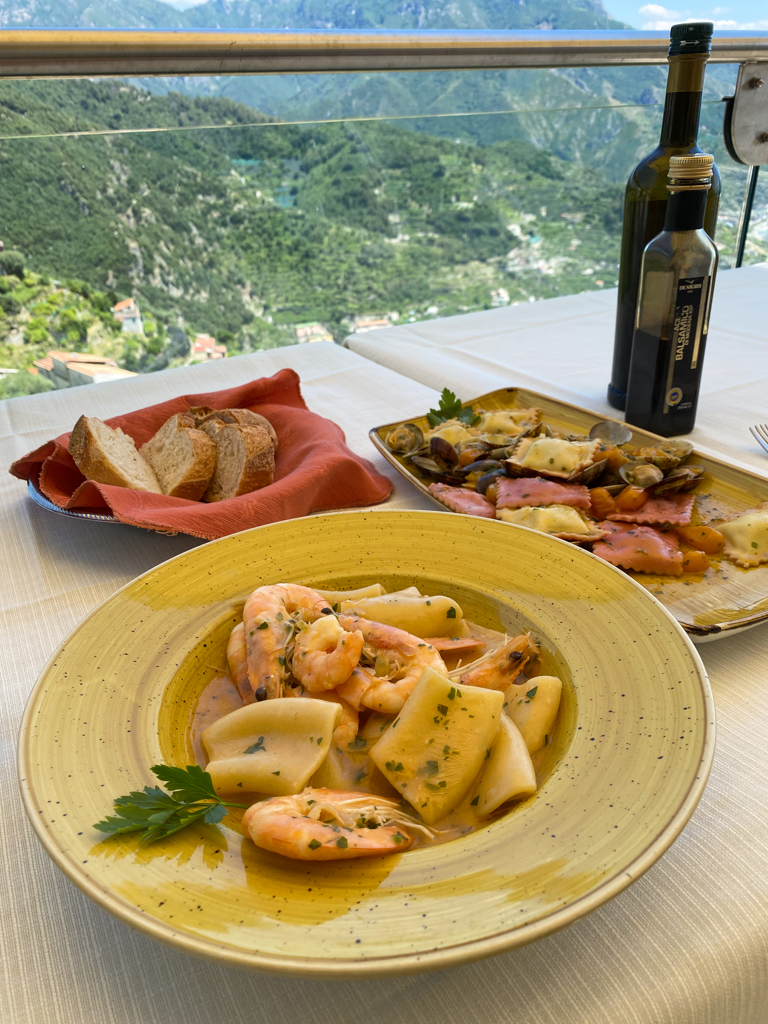
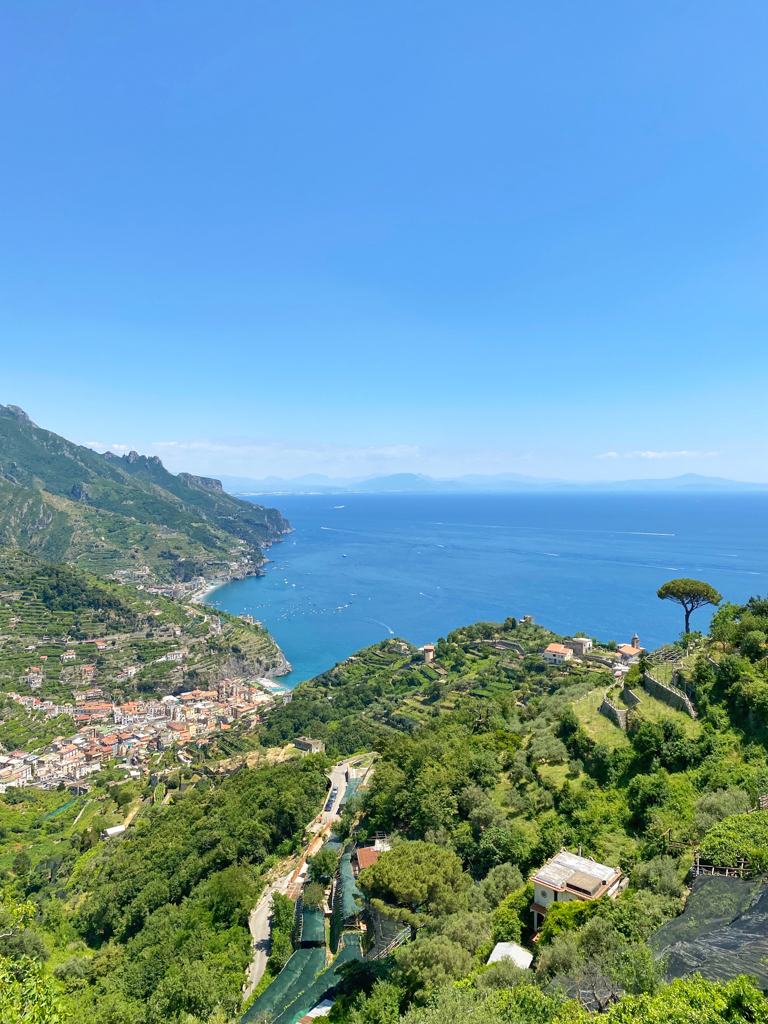
Positano
On Day 4, we took a day trip to the beautiful town of Positano, made particularly famous because of its feature in the movies Only You (1994), and Under the Tuscan Sun (2003). The Marina Grande beach is at the base of the cliffside town of Positano and is the most recognised beach in the town. Unlike Amalfi, the beachfront is run by private beach clubs, so you have to pay a fee to sit on the beach. While it may seem excessive, it’s not such a bad deal considering you get a great beach chair, a prime spot on the beach, and the option to order drinks and snacks. The other plus is that making the beach paid-entry, it prevents the beach from getting too overcrowded. We enjoyed our time on the beach and would do it again!

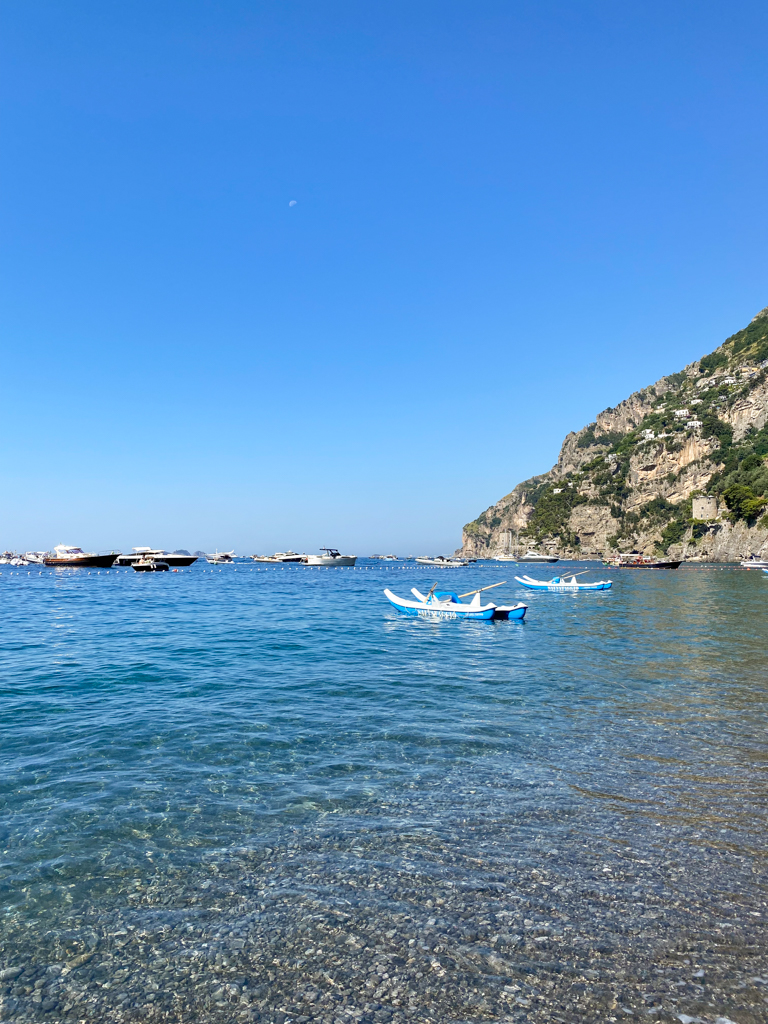
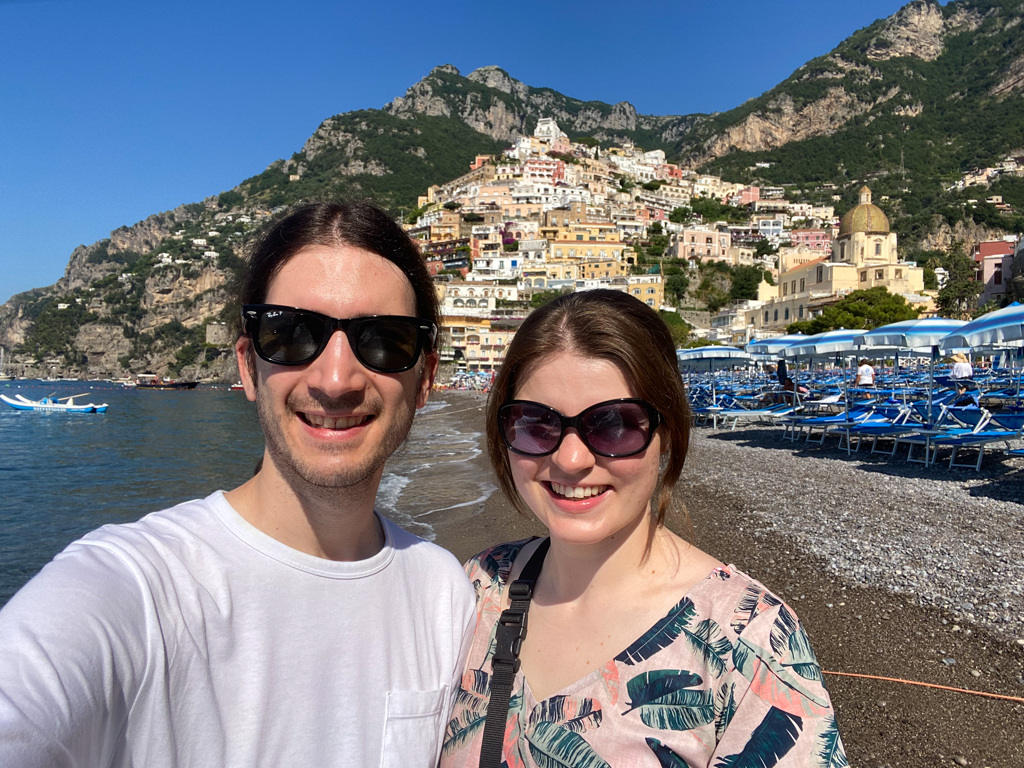
After the beach, we went for lunch at Chez Black, a Positano institution along the beachfront. It was supposedly the first restaurant in Positano, opening in 1949. If you go on their Instagram you’ll see all these photos of famous people visiting this iconic spot. Their food is traditional and comforting, though not the highlight of the place. The charm comes from the wonderful service and incredible location.


After lunch, we walked around the town. In addition to the beaches, cliffs, and historic sites, clothing stores and restaurants are scattered throughout Positano, attracting tourists from around the world. The tiny little streets were filled with people shopping and eating.


We went back to Positano a few days later for a very special dinner at Rada. They have two restaurants, one on the beachfront and the other on a rooftop. We had booked the rooftop several weeks in advance and I can tell you that nowhere else beats the amazing view.

 The food was also lovely. The service was impeccable. What more could you ask for? We started with some amuse-bouche and a fine selection of breads and crackers.
The food was also lovely. The service was impeccable. What more could you ask for? We started with some amuse-bouche and a fine selection of breads and crackers.
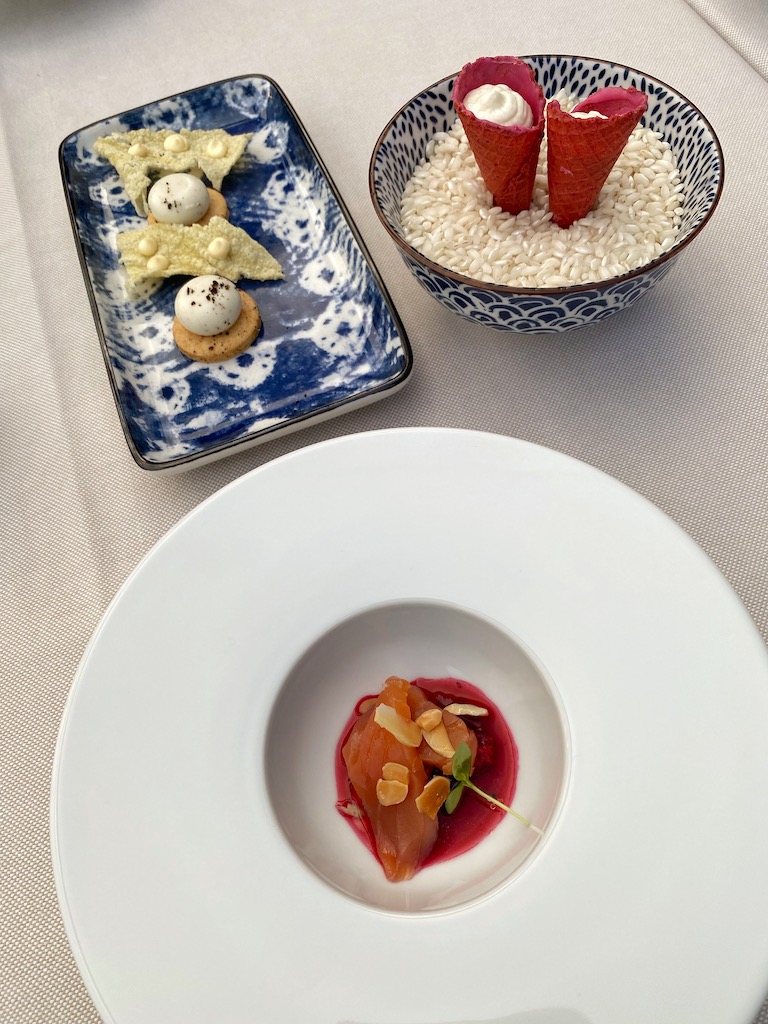

Our first course was the red prawn carpaccio and our second was roasted scallops, peas, asparagus and black truffle. Both dishes were delicate and delicious.
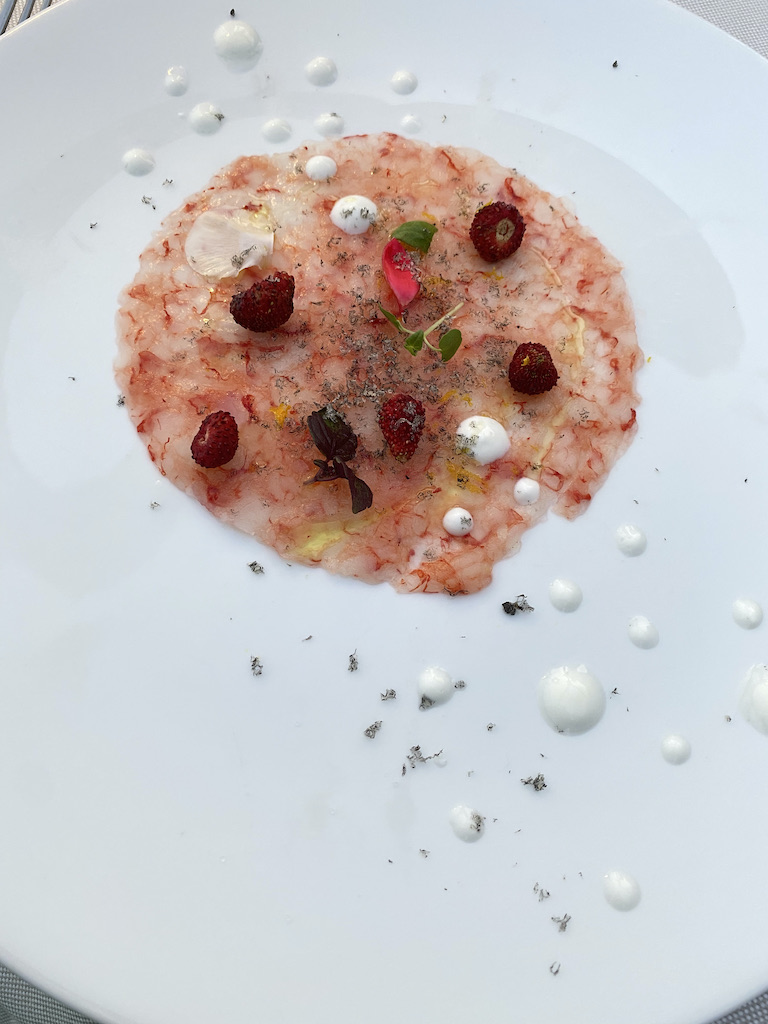

Our mains were the spaghettone (a thicker spaghetti) with sea urchin, anemone and samphire, and the black cod. I don’t have a photo of the cod, but both of these dishes were my favourite of the evening.
 Up next were several rounds of desserts. The first was some sort of sorbet. We then had a ‘gold ingot’ each which was the most decadent piece of chocolate (a good thing!). We also had a few post-dessert treats too — we certainly were spoiled!
Up next were several rounds of desserts. The first was some sort of sorbet. We then had a ‘gold ingot’ each which was the most decadent piece of chocolate (a good thing!). We also had a few post-dessert treats too — we certainly were spoiled!

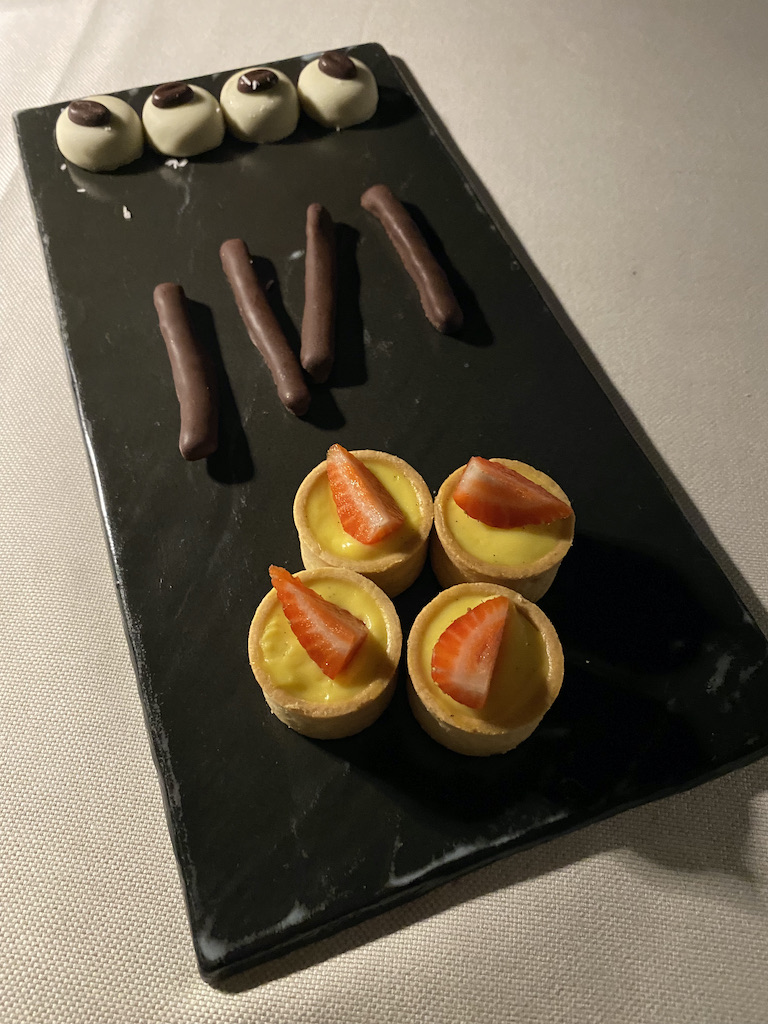


This is the part where I give a word of warning. It’s really difficult to find a way out of Positano at night! There is a taxi stand but taxis came by very rarely and the few cars that did show up had been pre-booked. We ended up waiting an hour for an available taxi and had to pay a small fortune to go back to Amalfi. Nonetheless, everything was sorted out and all in all, it was an amazing evening.
Atrani
On our fifth day, we took it easy as I actually had been quite ill with some sort of chest/throat infection. Just as the sun was starting to set we went on a little walk to the nearby village, Atrani. It’s a gorgeous, tiny place that reminded me of a setting from The Little Mermaid. It really is tiny as the municipality of Atrani has a surface area of 0.12 km2, making it the smallest in all of Italy!
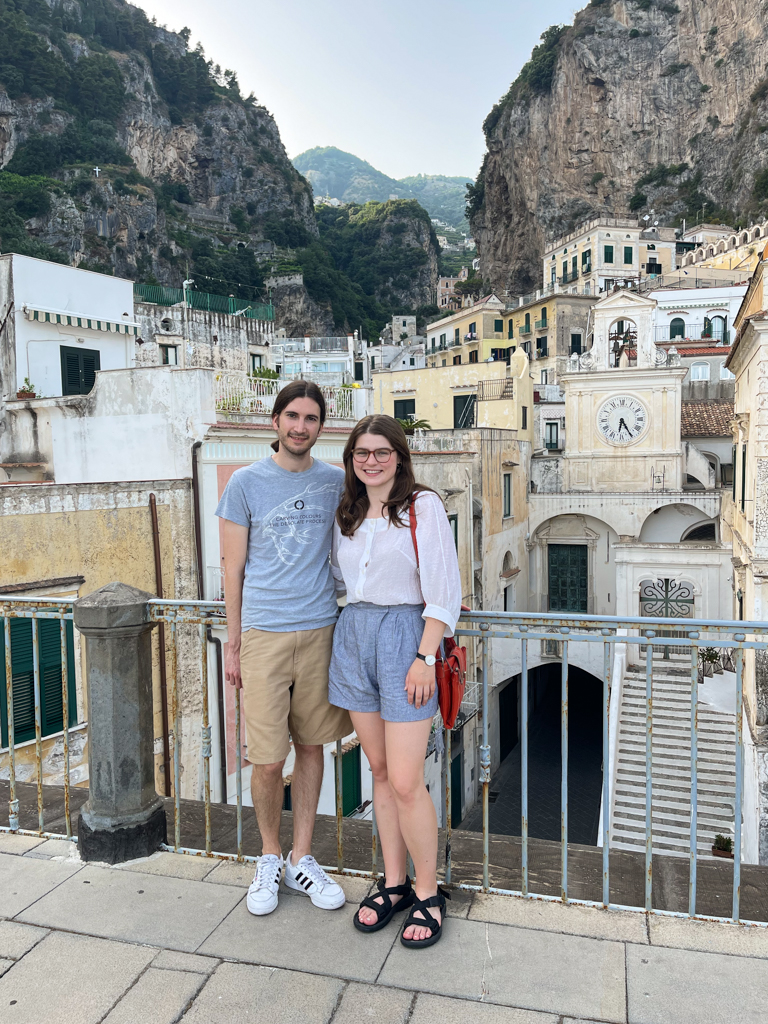

Atrani is isolated from car traffic because the old homes are along the coast. The central square of Atrani leads directly to the beach and the sea. The town is regarded as one of, if not the most, beautiful towns in Italy because of its setting between two mountains and the fact that it has stayed most true to its original medieval structure.
The town is also now becoming famous again because it is the filming location for the Netflix series, Ripley, which premiered in April 2024. The location is incredible, so it really suits the black-and-white style of the series.
 We loved the town so much that the next day we went back to Atrani first thing in the morning to go to the small, but lovely beach. If you go early there are very few people and honestly, it was my favourite beach of the whole trip. You can’t beat the surroundings.
We loved the town so much that the next day we went back to Atrani first thing in the morning to go to the small, but lovely beach. If you go early there are very few people and honestly, it was my favourite beach of the whole trip. You can’t beat the surroundings.


Minori
On Day 7 we ventured back out to visit two towns. In the morning we visited Minori. Minori in particular has had a long culinary tradition and so is nicknamed “City of Taste” (Città del gusto) or “Eden of the Amalfi Coast” (Eden della Costiera amalfitana).
 As shown by archaeological research, Minori was the oldest inhabited site on the Amalfi Coast. We visited the Roman Maritime Archeological Villa, which dates back to the 1st century BCE.
As shown by archaeological research, Minori was the oldest inhabited site on the Amalfi Coast. We visited the Roman Maritime Archeological Villa, which dates back to the 1st century BCE.
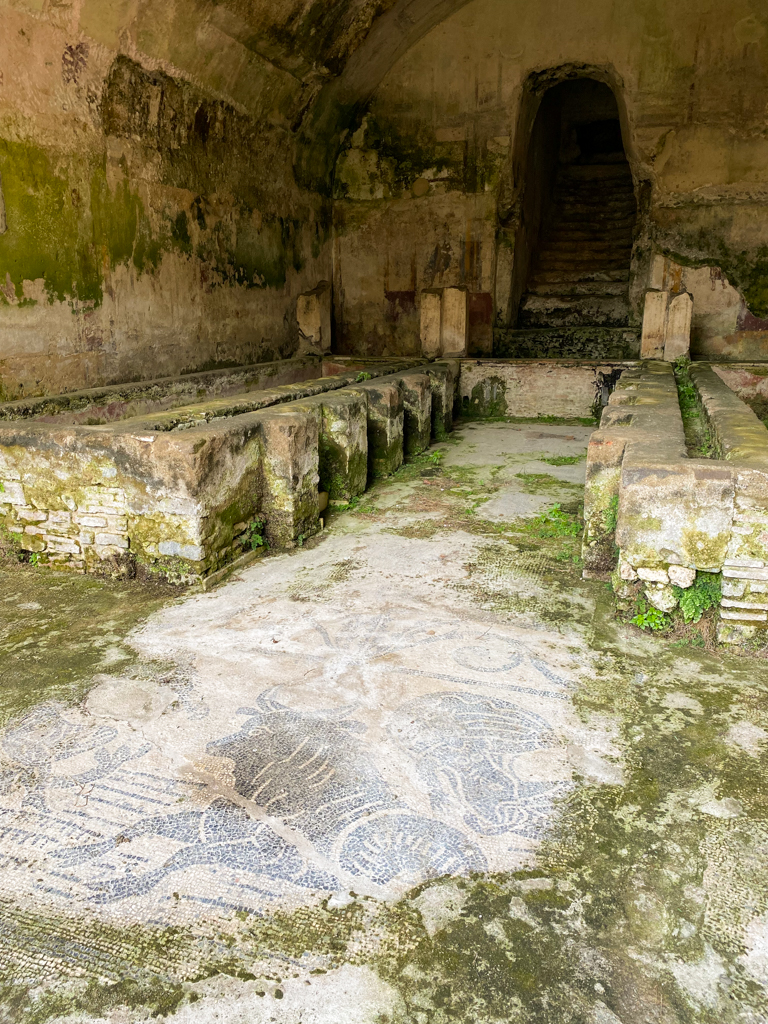

We walked around the small town and then stopped for a wonderful treat at Pasticceria Sal De Riso. Sal De Riso, hailing from Minori, is one of Italy’s most well-known Master Pastry Chefs. I felt so lucky to be able to visit his patisserie in Minori. One of his most famous pastries is Delizia al Limone. This dessert was invented by another pastry chef from the Amalfi Coast in 1978, however, Sal De Riso perfected the recipe is now the dessert is most associated with him and his patisserie. Delizia al Limone is a lemon sponge cake that is filled with lemon cream, brushed with Limoncello syrup and covered in a lemon and whipped cream glaze. It’s absolutely amazing and one of my favourite desserts in the whole world.
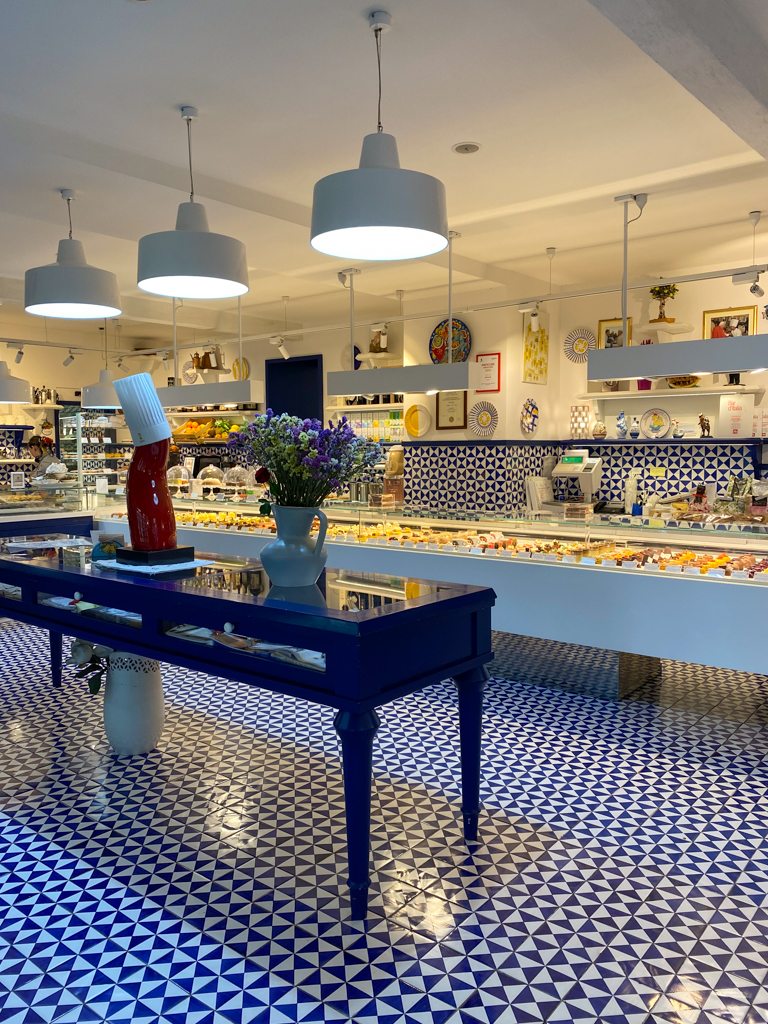

Cetara
After our delicious treat, we hopped back on the ferry to visit Cetara in the afternoon.
 The village was originally a settlement for a group of armed Muslims (called Saracens) in 880. Many of the towns along the Amalfi coast used to be fishing towns, but Cetara is one of the only ones that has retained this identity. Cetara is known for its fishing of tuna, sardines and anchovies.
The village was originally a settlement for a group of armed Muslims (called Saracens) in 880. Many of the towns along the Amalfi coast used to be fishing towns, but Cetara is one of the only ones that has retained this identity. Cetara is known for its fishing of tuna, sardines and anchovies.
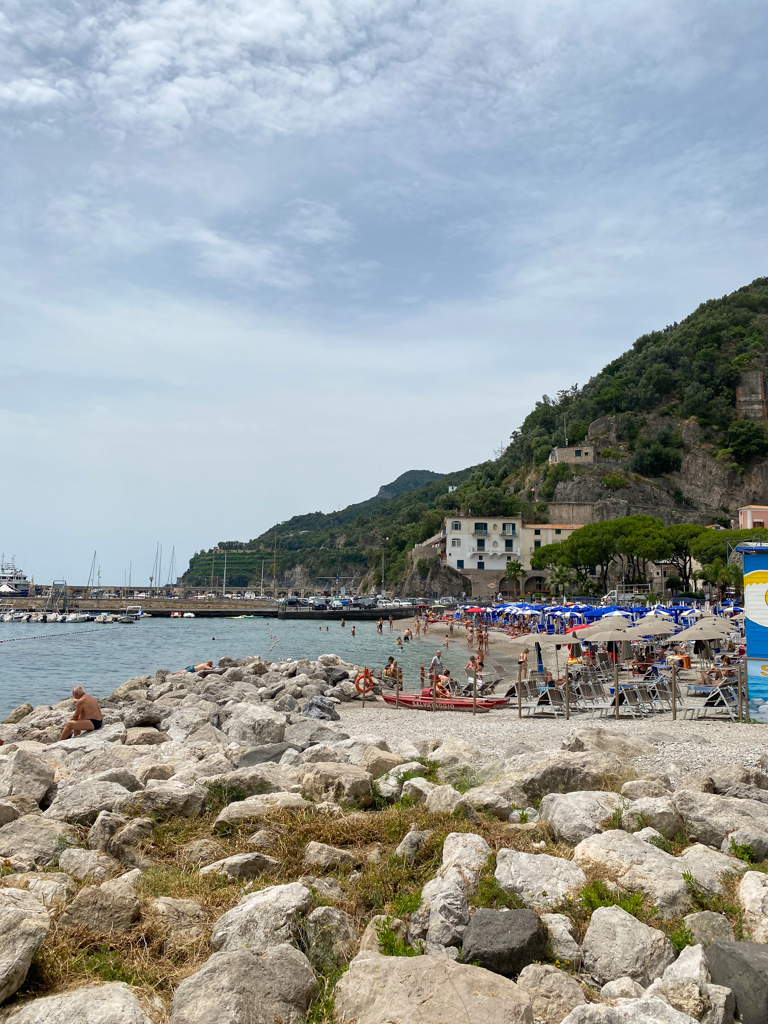

That’s why for lunch we had some of these fish dishes! We went to Ristorante Dea mangiona and had salt-cured anchovies on toast, fried anchovies, seared tuna, and scialatielli with fresh anchovies, cherry tomatoes and an anchovy sauce. There were lots of anchovies and we were simply delighted.


The Amalfi Coast has a lot to offer, each setting more beautiful than the next. While I loved our base of Amalfi, I really enjoyed our day trips. There’s something about hopping on the ferry, viewing the coastline along the day, and landing right in the middle of a quaint, and beautiful town that makes the whole thing so magical.
I loved these day trips as each town was cute and charming in its own distinct way. Until next time, Italia!

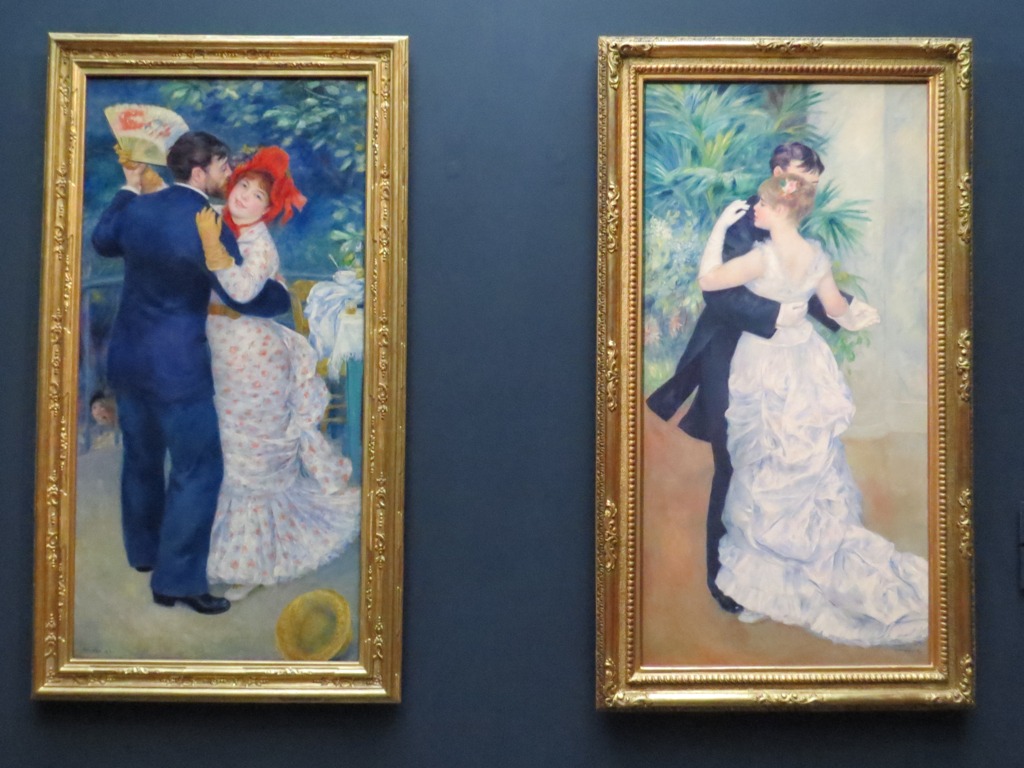

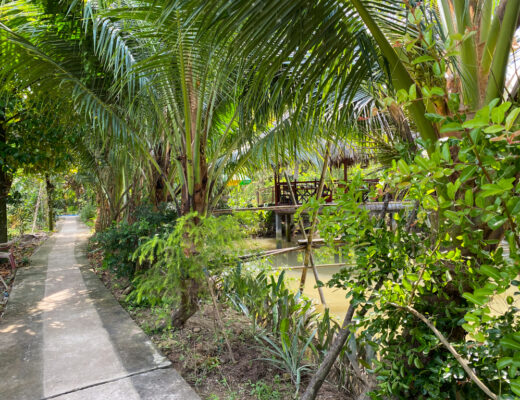
No Comments